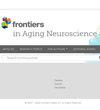波多黎各队列中的全基因组关联分析和掺杂图谱支持第 12 号染色体上的阿尔茨海默病风险基因座
IF 4.1
2区 医学
Q2 GERIATRICS & GERONTOLOGY
引用次数: 0
摘要
导言西班牙/拉美裔人群在阿尔茨海默病(AD)遗传研究中的代表性不足。波多黎各人(PR)是三方混血(欧洲人、非洲人和美洲印第安人)人口,是美国大陆第二大西班牙裔群体。我们的研究包括全基因组测序(WGS)和来自 648 名波多黎各人(345 名 AD,303 名认知功能未受损者)的表型数据。我们采用了广义线性混合模型,对性别、年龄、人群亚结构和遗传关系矩阵进行了调整。为了推断本地祖先,我们将数据集与 HGDP/1000G 参考面板合并。结果我们在染色体 12q13 上的 SLC38A1 和 SCN8A 基因中发现了提示性信号。在独立的数据集中,该区域与之前研究中的 AD 连接区域(12q13)重叠,进一步证实了这一点。单变量非洲 AM 分析发现了位于同一区域的一个提示性祖先区块(p = 7.2×10-6)。祖先感知方法表明,该区域既有欧洲人的祖先背景,也有非洲人的祖先背景,两者都对该区域的风险有影响。结论PR GWAS 和 AM 分析在 12 号染色体上发现了一个提示性的 AD 风险位点,其中包括 SLC38A1 和 SCN8A 基因。我们的研究结果表明了设计 GWAS 和祖先认知方法以及将代表性不足的人群纳入 AD 遗传研究的重要性。本文章由计算机程序翻译,如有差异,请以英文原文为准。
Genome-wide association analysis and admixture mapping in a Puerto Rican cohort supports an Alzheimer disease risk locus on chromosome 12
IntroductionHispanic/Latino populations are underrepresented in Alzheimer Disease (AD) genetic studies. Puerto Ricans (PR), a three-way admixed (European, African, and Amerindian) population is the second-largest Hispanic group in the continental US. We aimed to conduct a genome-wide association study (GWAS) and comprehensive analyses to identify novel AD susceptibility loci and characterize known AD genetic risk loci in the PR population.Materials and methodsOur study included Whole Genome Sequencing (WGS) and phenotype data from 648 PR individuals (345 AD, 303 cognitively unimpaired). We used a generalized linear-mixed model adjusting for sex, age, population substructure, and genetic relationship matrix. To infer local ancestry, we merged the dataset with the HGDP/1000G reference panel. Subsequently, we conducted univariate admixture mapping (AM) analysis.ResultsWe identified suggestive signals within the SLC38A1 and SCN8A genes on chromosome 12q13. This region overlaps with an area of linkage of AD in previous studies (12q13) in independent data sets further supporting. Univariate African AM analysis identified one suggestive ancestral block (p = 7.2×10−6 ) located in the same region. The ancestry-aware approach showed that this region has both European and African ancestral backgrounds and both contributing to the risk in this region. We also replicated 11 different known AD loci -including APOE - identified in mostly European studies, which is likely due to the high European background of the PR population.ConclusionPR GWAS and AM analysis identified a suggestive AD risk locus on chromosome 12, which includes the SLC38A1 and SCN8A genes. Our findings demonstrate the importance of designing GWAS and ancestry-aware approaches and including underrepresented populations in genetic studies of AD.
求助全文
通过发布文献求助,成功后即可免费获取论文全文。
去求助
来源期刊

Frontiers in Aging Neuroscience
GERIATRICS & GERONTOLOGY-NEUROSCIENCES
CiteScore
6.30
自引率
8.30%
发文量
1426
期刊介绍:
Frontiers in Aging Neuroscience is a leading journal in its field, publishing rigorously peer-reviewed research that advances our understanding of the mechanisms of Central Nervous System aging and age-related neural diseases. Specialty Chief Editor Thomas Wisniewski at the New York University School of Medicine is supported by an outstanding Editorial Board of international researchers. This multidisciplinary open-access journal is at the forefront of disseminating and communicating scientific knowledge and impactful discoveries to researchers, academics, clinicians and the public worldwide.
 求助内容:
求助内容: 应助结果提醒方式:
应助结果提醒方式:


